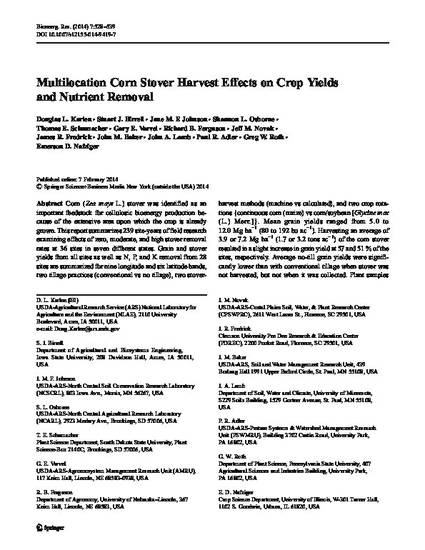
Corn (Zea mays L.) stover was identified as an important feedstock for cellulosic bioenergy production because of the extensive area upon which the crop is already grown. This report summarizes 239 site-years of field research examining effects of zero, moderate, and high stover removal rates at 36 sites in seven different states. Grain and stover yields from all sites as well as N, P, and K removal from 28 sites are summarized for nine longitude and six latitude bands, two tillage practices (conventional vs no tillage), two stover-harvest methods (machine vs calculated), and two crop rotations {continuous corn (maize) vs corn/soybean [Glycine max (L.) Merr.]}. Mean grain yields ranged from 5.0 to 12.0 Mg ha−1 (80 to 192 bu ac−1). Harvesting an average of 3.9 or 7.2 Mg ha−1(1.7 or 3.2 tons ac−1) of the corn stover resulted in a slight increase in grain yield at 57 and 51 % of the sites, respectively. Average no-till grain yields were significantly lower than with conventional tillage when stover was not harvested, but not when it was collected. Plant samples collected between physiological maturity and combine harvest showed that compared to not harvesting stover, N, P, and K removal was increased by 24, 2.7, and 31 kg ha−1, respectively, with moderate (3.9 Mg ha−1) harvest and by 47, 5.5, and 62 kg ha−1, respectively, with high (7.2 Mg ha−1) removal. This data will be useful for verifying simulation models and available corn stover feedstock projections, but is too variable for planning site-specific stover harvest.
Available at: http://works.bepress.com/stuart_birrell/45/

This article is from BioEnergy Research 7 (2014): 528–539, doi:10.1007/s12155-014-9419-7.